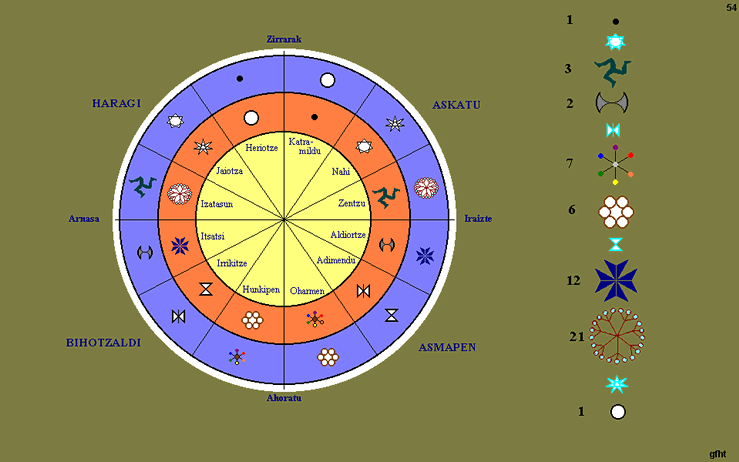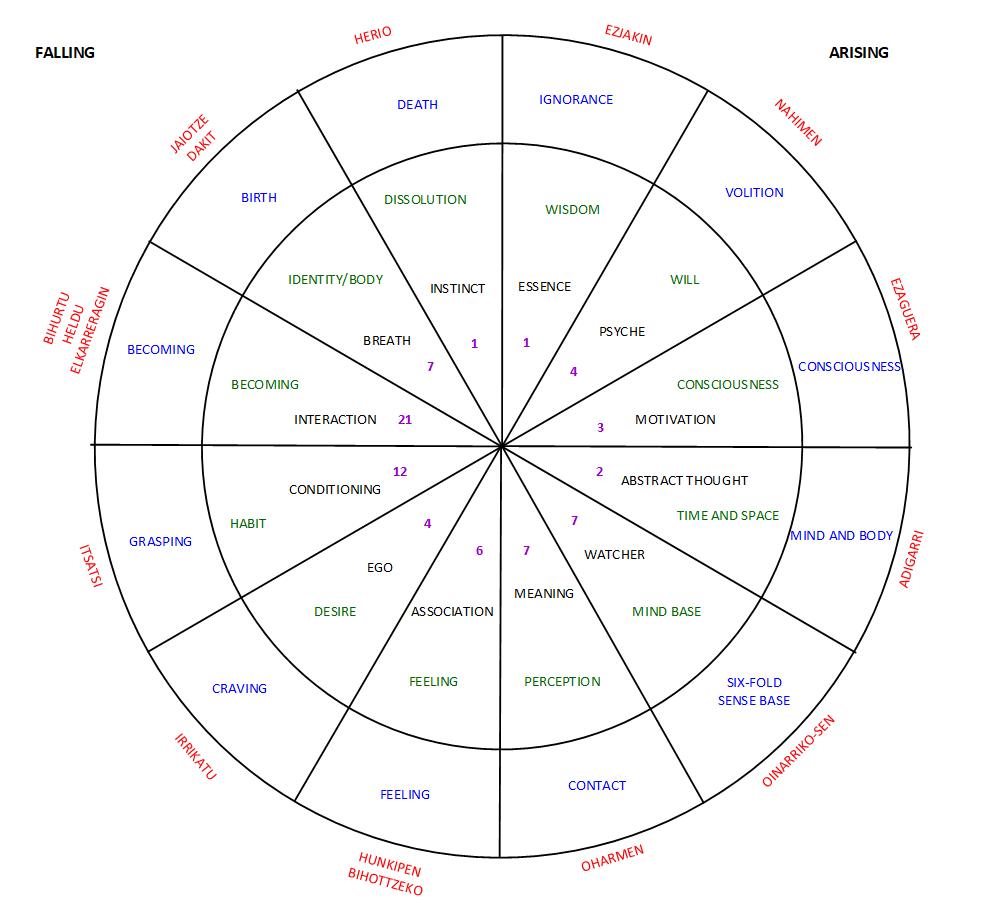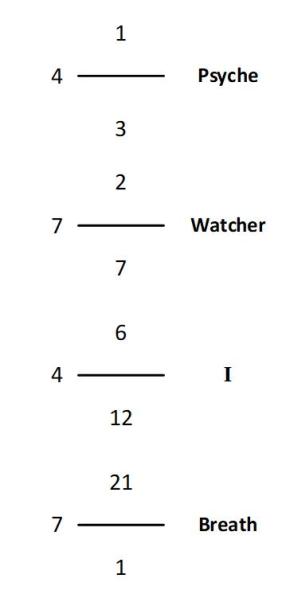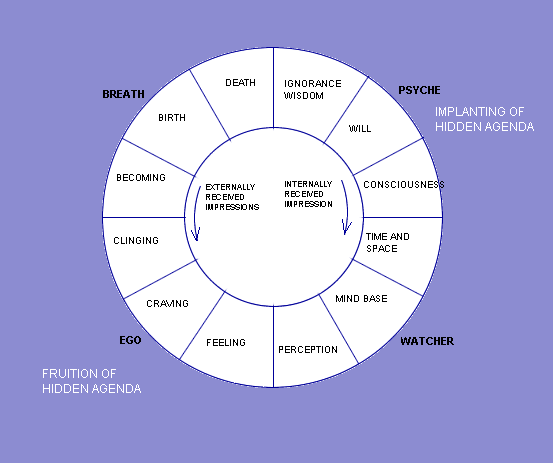Everything that is has a cause which drives the wheel of life…

Many of the Sareoso diagrams include a cycle of twelve links with some similarity to the Buddhist “Wheel of Life”. This wheel embodies the view that every event is caused by something and results in something else. One example of this wheel is found in Diagram 54, where the 12 steps are labelled as follows.
| KATRAMILDU | Ignorance |
| NAHI | Will |
| ZENTZU | Consciousness |
| ALDIORTZE | Time & Space |
| ADIMENDU | Mind-base |
| OHARMEN | Perception |
| HUNKIPEN | Feeling |
| IRRIKITZE | Craving |
| ITSATSI | Grasping |
| IZATASUN | Becoming |
| JAIOTZA | Birth |
| HERIOTZE | Death |
There are many interpretations of the wheel, but one possible understanding is as follows, in the story of a human life:
A ripple in stillness (Ignorance) causes a turning away from unity towards creation and the Will-to-Be. This Will-to-Be causes a formless primordial Consciousness, and this in turn results in the beginning of time and space. The child is conceived.
With time and space, the possibility of senses and Mind-base arises, and then Perception begins. Every perception causes a Feeling, and we Crave pleasant feelings and the cessation of unpleasant ones.
We Grasp that which is pleasant and our being develops around this. We become what we grasp. The child is Born, but everything that is born immediately begins to grow old and die. In the final step of death, the wheel returns to stillness. Will another cycle take place?
The cycle can also work in reverse. For example, if we can cease craving, then we can simply observe the arising of feelings, and the moment of perception itself.
The Buddhist Wheel of Life
In Buddhism the twelve links are usually seen as referring to the cycle of birth and rebirth, and in the traditional wheel of life each link is illustrated by an image, which helps with understanding and remembering the meaning of the link. A cycle can be started anywhere, but a convenient starting place is Ignorance. Here we can imagine the process that begins when someone dies, leading towards rebirth:
Ignorance is represented by a blind person. After death, a new cycle of rebirth is started because of ignorance of the possibility of escaping from the wheel.
[Will] Karma or formative actions is represented by a potter shaping a vase on a wheel. Actions in previous lives have an effect in shaping the possibilities for the new life.
Consciousness is represented by a monkey swinging from a tree. This is consciousness without form. I see an analogue of this in the process of waking from deep sleep or a period of unconsciousness. I wake up but I don’t know where I am, and sometimes there is even a moment of not having any context at all, but quickly something slips into position.
[Time & Space] Name and Form is represented by a boat with an oarsman and passengers. This represents the body and mental aggregates, passing over the sea of samsara. In the process of rebirth, this is the consciousness attaching to a new body – perhaps at the moment of conception? In my ‘waking up’ example, this is the point where I begin to have a sense of who and where I am.
[Mind-base] Six Sources is represented by an empty house, because this link represents the mechanism of the senses (5 external and the internal ‘mind’) ready to operate. In rebirth, perhaps this is about the formation of the sense organs, such as the eyes and ears of the foetus. In my self-observation, maybe this represents moments when the senses are at rest and my mind is quiet.
[Perception] Contact is represented by a couple embracing. An object, a sense faculty and consciousness make contact and produce perception. We seem now to be looking in detail at the way that interaction with the world operates. A moment of contact begins a sequence of events. I suppose that in a lifetime, there are many moments of contact, which have cumulative consequences.
Feeling is represented by an arrow in the eye. This violent image represents our immediate reaction to a moment of contact. By ‘feeling’ what is meant is a simple assessment of the perception as pleasant, unpleasant or neutral. So for example, a perception of stubbing your toe is unpleasant, a perception of music might be pleasant, and a perception of wind blowing against the skin might be neutral.
Craving is represented by someone drinking. We want more of pleasant experiences, and we want to avoid unpleasant experiences.
Grasping is represented by picking fruit from a tree. We cling on to pleasant experiences, become attached to them. Looking in terms of rebirth, at death we reach out for another body.
Becoming is represented by a pregnant woman. One way of looking at this is that the previous set of links (perception to grasping) can represent the steady growth of the individual through a process of attachment, so that we become a particular person – of course this carries on through life, but can be seen as starting during foetal development in the womb. Aristotle is often quoted as saying “We are what we repeatedly do.”
Birth is represented by a woman giving birth. This can be understood as the moment of birth of a new individual, but also a continuous process of development – becoming, birth and then death. As soon as something is born, it begins to die, and the next link in the chain is old age and death.
Aging and death is represented by an old person and a corpse. In one sense, all of our life occurs in this one link from birth to death, but in another sense birth and death is going on in us all the time. And with death, we are back at the first link – ignorance will lead us into another rebirth.
Some Sources
Nice big photo of a wheel of life painting.
Some information by Thubten Chodron, an American Tibetan Buddhist Nun:
- The Wheel of Life.
- Links 4-12 (Name and Form, Six Sources, Contact, Feeling, Craving, Grasping, Becoming, Birth, Ageing and Death)
- Links 1-3: (Ignorance, Karma, Consciousness)
Richard Teall Talk on Dependent Origination at the Samatha Trust.
John Cianciosi talk on the Buddhist Wheel of Life at the Theosophical Society.
Wikipedia Article on Dependent Origination.
Wikipedia Article on the Buddhist Wheel of Life.
Book by Lama Jampa Thaye: Patterns in Emptiness: Understanding Dependent Origination in Buddhism, (Rabsel, 2019).





